Medieval Ireland/Éire sa Meanaoise
Published in Issue 4 (July/August 2011), Medieval History (pre-1500), Reviews, Volume 19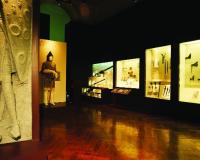
In the Medieval Ireland exhibition, boys of all ages will enjoy the armour and weapons on display.
The National Museum of Ireland in Kildare Street could be viewed as a collection of smaller themed museums rather than one large one, as the permanent collections on various aspects of Irish history are self-contained. It can be a rewarding experience to concentrate on just one of these instead of attempting to take in the whole building in one go.
The exhibition on medieval Ireland is a good example of this. It is best reached via the Viking exhibition on the first floor of the main exhibition hall. Concentrating on life and society in the Middle Ages, it is laid out thematically with display cabinets, information panels and interactive screens. The first area, ‘Power: kings, lords and warriors’, fulfils our expectations of medieval Ireland, portraying a society dominated by armed conflict. It is the history that we all learned in school.
You are met by an eye-catching life-size plaster cast of a knight, typical of the Anglo-Norman warriors who settled in Ireland, taken from a Cantwell family tomb effigy. This gallery balances well the two competing orders in Ireland, characterised as Irish kingship and lordship versus English lordship and administration.
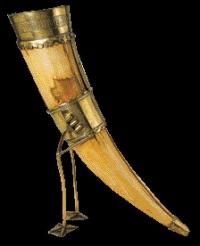
The Charter Horn of Art MacMurrough Kavanagh, Borris, Co. Carlow. This ceremonial drinking horn, a symbol of the kingship of Leinster, is the only piece of Irish regalia to have survived the Middle Ages.
Of course, by the Middle Ages there was a lot of commonality between the two, as Irish chieftains adapted to the new ways and English knights integrated into the Gaelic order. A display cabinet dedicated to music and poetry contains fragments of an Irish harp (and a full reconstruction) alongside decorated books representing both cultures. Another on the ‘lordly table’ contains candlesticks, knives, spoons, jugs and methers. The theme of the lordly life is carried on with artefacts of jewellery, chess pieces and hunting.
Irish kingship is represented by a display devoted to the MacMurrough Kavanaghs, which contains the ornate shrine of the Book of St Molnag and the even more impressive Charter Horn of Art MacMurrough Kavanagh. This decorated hunting horn was a symbol of the wealth, sophistication and sovereignty of the kings of Leinster. Apart from a mannequin representing Lady Margaret Butler in court costume, the theme of warfare dominates the rest of the gallery, from the other mannequin of a late medieval warrior to the guns that signalled the end of the medieval period. Among the bows, swords, axes and helmets look out for the so-called mace of Brian Boru and the magnificent recreation of the Monasterevin sword. These artefacts do not just represent military conflict but also craftsmanship, art and a symbolism that would easily be read by the medieval Irish.
There is more to the Middle Ages than this, however. Follow the stairs up to the next gallery, where other aspects of medieval Ireland are explored in country, town and church. It opens with a collection of large cooking pots in iron and copper. Nearby are farming implements such as a wooden spade, an iron ploughshare, quernstones and woodenmethers. One of the latter contains bog butter preserved for hundreds of years.
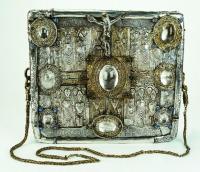
Shrine of the Miosach, Clonmany, Co. Donegal. This eleventh-century book shrine, redecorated in 1534, was originally associated with St Cairneach, patron saint of Dulane, Co. Meath, but in the later Middle Ages it was absorbed into the cult of St Columba.
Going into the next area you are met by an array of tools from various trades that were prominent in this period: the carpenter, woodworker, blacksmith, precious metal-worker and stonemason. We can appreciate how the Middle Ages established the template for the centuries to follow when we see tools that are still used today, from axes and chisels to hammers and saws. The section on trade and commerce highlights not only the trade of various commodities within Ireland but also how the island was connected to the rest of the known world. There is an impressive collection of pots from France, Italy and Spain that were found in Ireland. Other presages of the future are the coins, weights and measures that ensured fair exchange and honesty in dealing. Thetowns that grew with trade are represented by the wax seals of Dundalk, Kilkenny, Mullingar and others, filling in the geography of medieval Ireland. We get some notion of how people dressed from the famous Irish mantle, woollen hats, coats, trews and the only woman’s dress on display.
On the way into the section on the church you pass the isolated figure of a síle-na-gig, the mysterious and lewd representation of the female form.I am told that it is there temporarily, pending a proper setting and explanatory label. The dominance of thechurch is reflected not just by the numberofartefacts but also by their opulence. The shrines for relics and missals are of finely worked metal decorated with gold, silver and precious stones.
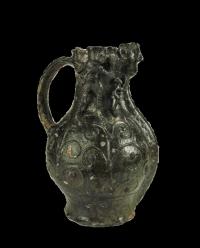
Found in excavations at High Street, Dublin, this elaborate green-glazed wine jug was made in the pottery kilns of Redcliffe, near Bristol, in England.
One example is the shrine of the Miosach, associated with St Cairneach of Dulane, Co. Meath. This dates from the eleventh century. In 1534 a new front was added of silver foil decorated with panels depicting the Virgin and Child and Saints Patrick, Colmcille and Brigid. Its appearance is enhanced by eight polished rock crystals. There is also a plethora of crosiers, bells, seals and crosses made of stone, wood, bronze and more expensive materials. Statues,gravestones and similar items call to mind the churches and monasteries that were once common before the Reformation.
This permanent exhibition covers many aspects of medieval Irish society. The struggle between the Gael and the Gall and the hybrid lordly society to which it gave rise is well covered in the first gallery, but perhaps the second section is the most important. It is no bad thing to be reminded that there were towns and cities in Ireland and that these were not all confined to the coast. Places inland like Kilkenny and Mullingar played a crucial role in commerce, and their social interaction was not confined to the ‘English’ of Ireland. Too often we get caught up in the broad sweep of Irish history with its invasions, wars and rebellions, forgetting that people farmed, towns grew and trade was carried on across the island and beyond.
This exhibition shows us the rich texture of medieval Ireland and the complexity of society. Next time you have the chance to visit the National Museum, do not flit from room to room but stop to consider one exhibition, such as that on Tara, bog bodies or the Vikings. They are good examples of making the best use of space and the benefits of arranging objectsthematically.
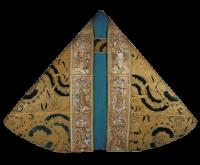
Late fifteenth- to early sixteenth-century embroidered cope (a vestment worn by priests on ceremonial occasions), Waterford Cathedral. Made of Italian silk, the embroidery is Flemish.
(All images: National Museum of Ireland)
In the Medieval Ireland exhibition, boys of all ages will enjoy the armour and weapons on display, but the other aspects of medieval society are fascinating too and well worth spending time over. HI
















